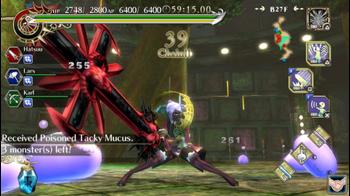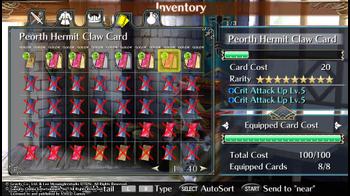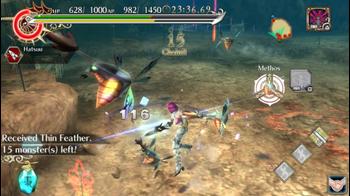
Ragnarok Odyssey Ace Review
It feels like I have been covering more and more of these types of Action RPGs lately. You know the type - the ones that feature equipment-based progression, free-roaming combat, and a quest-based story advancement. Only a couple of years ago, the Vita was severely lacking in these types of games after having been completely devoid of the genre with the omission of the consummate favorite, Monster Hunter, a series that owes a lot to Sony’s PSP for making it so popular in the first place.
Here we are just a couple years into the lifespan of the Vita, and we already have a handful of titles to choose from: Soul Sacrifice, Toukiden, God Eater 2, the upcoming Freedom Wars, and more surely under development, each attempting to make up for that absence.
Now, I did not get a chance to play the original Ragnarok Odyssey when it first arrived here in the West early last year, but I did hear good things about how it did right by the formula and offered something for Ragnarok Online fans such as myself to enjoy, so I come into this already with experience of the series. For those who have played the original, for your information, this version update brings with it some neat little additions including the Tower of Yggdrasil which features 200 levels of randomly-generated dungeons, a new interface, and just a nice share of content on top.
When starting the game, players will have six different classes to choose from: Swordsman, Magic, Cleric, Hammersmith, Hunter, and Assassin. They each obviously have their own class-specific benefits and hindrances, like how the Hammersmith is all about power but suffers from low defense. Fortunately you can change your class at any time when not out on a mission, letting this first choice instantly become a trivial one.
Once you get into the meat of the character creation system, this is where things get astonishingly deep. The options include 9 different skin tones, 20 different faces, 27 different hairstyles (including a colorbox for that perfect accent), and 20 different voice types - all of this per gender. It’s a nice wealth of choices for a game where players may spend a lot of their time online.
Like Toukiden, story progression is pretty straightforward - you talk to the woman at the Quest Counter, and she will let you choose from a different variety of quests that are sorted by Chapter and fall under one of three categories: Story, Free, and Extra. Story obviously moves the plot along; you may have to do a few Free quests to unlock the next Story mission; and Extra are challenging objectives sure to test even seasoned players as the game goes along.
You are allowed thirty minutes to complete most of the quests, but I never felt like I was knocking on the door of failure from running out of time. This game is the very definition of a snack-sized gaming experience as they mostly fell under “Kill X number of monsters” or “Fetch X number of items”. The challenge certainly comes to a head as the game heads into the home stretch, and I could certainly see how someone who was only a Mage or Cleric having a harder time winning battles if they were alone, though the game lets you hire a mercenary partner to bring along with you.
Combat itself can be rather fun as well. Most of the time is spent pressing the Triangle button to dispatch enemies, along with a class-specific move with the Circle button called an "Ace Skill". These special skills liven things up a bit by unleashing a powerful class move such as a giant swipe that launches creatures in the air or rains down powerful magic. Every action is piloted by the AP bar (or the stamina meter) which drains fairly quickly when attempting to dash from one place to the next or leaping into the air. Fortunately, it also recharges at a good click as well to avoid being aggravating.
Much like Ragnarok Online, there are a wide variety of Cards to pick up that are randomly dropped from different monsters, offering a solid measure of benefits to players, such as boosting stats such as strength, defense, agility, and health, or even status effects like ice or poison to their weapons. There is a cost to each card that takes up space on a character’s Weapon or Armor which can be expanded by visiting the Tailor or Blacksmith, and much like Ragnarok Online, it’s the correct combination of cards depending on the situation that can make all of the difference, and it’s a great feature for the game. Aside from cards, materials can also be collected from the different dungeons to help refine equipment and increase their effectiveness.
To the left of the health bar is a Tension meter that fills up as you either kill enemies or collect red crystals that can be picked up from boxes and barrels found around the map. Once full, Dainsleif can be activated which increase things like attack and defense while reducing staggering, all of this at the cost of health which drains when not dealing damage, but can also act as a way to restore health if used in the right situation. This has saved me from some pretty dire situations, even if the game is forgiving enough to let you die a total of three times in battle before they throw you back into town, though not forgiving enough to ramp up the difficulty at random times inside of a dungeon.
Nobuo Uematsu, a person whose name seems to be out there a heck of a lot more than it used to be, helped to create a whole new soundtrack for Ragnarok Odyssey Ace, and it certainly does wonders - the music here is very well done and fits the different environments.
The game also controls well. Whether I was dashing in to fight an enemy up close or trying to pick it off from afar, I never felt like I wasn’t able to maneuver my character the way I wanted them to, even when I was airborne, which is due in part to the lock-on system that did its job like I expected it to. Sure, sometimes if I didn’t have all of the enemies on screen and lost contact, I usually wound up getting stabbed from behind, but I prefer that over the camera whipping around all over the place trying to keep up with the action.
I also liked how the game utilized the Playstation Vita’s touchscreen controls in a smart manner. I can activate a skill by tapping the appropriate “Ace Skill”; select an item on the Potion Slot; zoom in on the map; activate one of the social features such as a little dance or a fist pump - you can even set it to have you move the camera with your finger, though I never felt the urge to activate this.
Ragnarok Odyssey Ace does a wonderful job in compiling an experience fans of this type of genre can enjoy. The character creation system is deep, the accompanying equipment customization features are great, and there is a ton of content to delve into with this update to the original, especially with the Tower of Yggdrasil.
Sure, it may find itself in a bit of a rut by relying too heavily on the same tried-and-true questing system that loses a good level of entertainment fairly quickly, the plot is so transparent that I already forget what the story was all about, and the combat can get fairly repetitive after a while, but what it does well is so admirable that it makes up for a degree of its shortcomings, especially with its budget pricetag and the beautiful visuals on the Vita.


